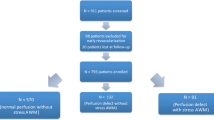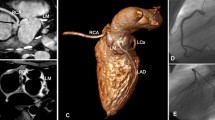Abstract
The aim of the study was to evaluate safety and feasibility of dobutamine cardiovascular magnetic resonance (CMR) in patients with proven or suspected coronary artery disease. Dobutamine CMR was evaluated retrospectively in 400 consecutive patients with suspicion of myocardial ischemia. Dobutamine was infused using an incremental protocol up to 40 μg/kg body weight per minute. All anti-anginal medication was stopped 4 days before the CMR study and infusion time of dobutamine was 6 min per stage. Hemodynamic data, CMR findings and side effects were reported. Patients with contraindications to CMR (metallic implants and claustrophobia) were excluded from analysis. Dobutamine CMR was successfully performed in 355 (89%) patients. Forty-five (11%) patients could not be investigated adequately because of non-cardiac side effects in 29 (7%) and cardiac side effects in 16 (4%) patients. Hypotension (1.5%) and arrhythmias (1%) were the most frequent cardiac side effects. One patient developed a severe complication (ventricular fibrillation) at the end of the study. There were no myocardial infarctions or fatal complications of the stress test. The most frequent non-cardiac side effects were nausea, vomiting and claustrophobia. Age >70 years, prior myocardial infarction and rest wall motion abnormalities showed no significant differences with side effects (P>0.05). Dobutamine CMR is safe and feasible in patients with suspicion of myocardial ischemia.
Similar content being viewed by others
References
Pennell DJ, Underwood SR, Manzara CC, Swanton RH, Walker JM, Ell PJ, Longmore DB (1992) Magnetic resonance imaging during dobutamine stress in coronary artery disease. Am J Cardiol 70:34–40
Nagel E, Lehmkuhl HB, Bocksch W, Klein C, Vogel U, Frantz E, Ellmer A, Dreysse S, Fleck E (1999) Noninvasive diagnosis of ischemia-induced wall motion abnormalities with the use of high-dose dobutamine stress MRI: comparison with dobutamine stress echocardiography. Circulation 99:763–770
Hundley WG, Hamilton CA, Thomas MS, Herrington DM, Salido TB, Kitzman DW, Little WC, Link KM (1999) Utility of fast cine magnetic resonance imaging and display for the detection of myocardial ischemia in patients not well suited for second harmonic stress echocardiography. Circulation 100:1697–1702
Kuijpers D, Ho KYJAM, Dijkman PRM van, Vliegenthart R, Oudkerk M (2003) Dobutamine cardiovascular magnetic resonance for the detection of myocardial ischemia using myocardial tagging. Circulation 107:1592–1597
American Heart Association, American College of Cardiology (1997) Guidelines for exercise testing. J Am Coll Cardiol 30:260–315
American Heart Association, American College of cardiology (2002) Guideline update for exercise testing. Circulation 106:1883–1892
Lipton MJ, Bogaert J, Boxt LM, Reba RC (2002) Imaging of ischemic heart disease. Eur Radiol 12:1061–1080
Sandstede JJ (2003) Assessment of myocardial viability by MR imaging. Eur Radiol 13:52–61
Dewey M, Borges AC, Kivelitz D, Taupitz M, Wagner S, Baumann G, Hamm B (2004) Coronary artery disease: new insights and their implications for radiology. Eur Radiol 14:1048–1054
Hundley WG, Morgan TM, Neagle CM, Hamilton CA, Rerkpattanapipat P, Link KM (2002) Magnetic resonance imaging determination of cardiac prognosis. Circulation 106:2328–2333
Cerqueira MD, Weissman NJ, Dilsizian V, Jacobs AK, Kaul S, Laskey WK, Pennell DJ, Rumberger JA, Ryan T, Verani MS (2002) Standardized myocardial segmentation and nomenclature for tomographic imaging of the heart. American Heart Association Writing Group on Myocardial Segmentation and Registration for Cardiac Imaging. Circulation 105:539–542
Sheffield LT (1988) Exercise stress test. In: Braunwald E (ed) Heart disease: a textbook of cardiovascular medicine, 4th edn. Saunders, Philadelphia, pp 223–241
Secknus MA, Marwick TH (1997) Evolution of dobutamine echocardiography protocols and indications: safety and side effects in 3,011 studies over 5 years. J Am Coll Cardiol 29:1234–1240
Picano E, Mathias WJ, Pingitore A, Bigi R, Previtali M (1994) Safety and tolerability of dobutamine-atropine stress echocardiography: a prospective multicentre study. Echo dobutamine international cooperative study group. Lancet 344:1190–1192
Mertes H, Sawada SG, Ryan T, Segar DS, Kovacs R, Foltz J, Feigenbaum H (1993) Symptoms, adverse effects and complications associated with dobutamine stress echocardiography. Experience in 1118 patients. Circulation 88:15–19
Zoghbi WA, Barasch E (1999) Dobutamine MRI: a serious contender in pharmacological stress imaging. Circulation 99:730–732
Nesto RW, Kowalchuk GJ (1987) The ischemic cascade: temporal sequence of hemodynamic, electrocardiographic and sypmtomaric expressions of ischemia. Am J Cardiol 59:23C–30C
Heyndrikx CR, Baic H, Nelkins P (1978) Depression of regional blood flow and wall thickening after brief coronary occlusion. Am J Physiol 234:653–660
Nagel E, Schneider U, Schall S, Ibrahim T, Schnackenburg B, Bornstedt A, Klein C, Lehmkuhl HB, Fleck E (2000) Magnetic resonance real time imaging for the evaluation of left ventricular function. J Cardiovasc Magn Reson 2:7–14
Schalla S, Klein C, Paetsch I, Lehmkuhl H, Bornstedt A, Schnackenburg B, Fleck E, Nagel E (2002) Real-time MR image acquisition during high-dose dobutamine hydrochloride stress for detecting left ventricular wall-motion abnormalities in patients with coronary artery disease. Radiology 224:845–851
Poldermans D, Fioretti PM, Boersma E, Bax JJ, Thomson IR, Roelandt JRTC, Simoons ML (1999) Long-term prognostic value of dobutamine-atropine stress echocardiography in 1737 patients with proven or suspected coronary artery disease. Circulation 99:757–762
Taillefer R, Ahlberg AW, Masood Y, White CM, Lamargese I, Mather JF, McGill CC, Heller GV (2003) Acute beta-blockade reduces the extent and severity of myocardial perfusion defects with Dipyridamole Tc-99m Sestamibi SPECT imaging. J Am Coll Cardiol 42:1475–1483
Miller RR, Olson HG, Amsterdam EA, Mason DT (1975) Propranolol withdrawal rebound phenomenon. Exacerbation of coronary events after abrupt cessation of antianginal therapy. N Engl J Med 293:416–418
Lindenfeld J, Crawford MH, O’Rourke RA, Levine SP, Montiel MM, Horwitz LD (1980) Adrenergic responsiveness after abrupt propranolol withdrawal in normal subjects and in patients with angina pectoris. Circulation 62:704–711
Myers MG, Wisenberg G (1977) Sudden withdrawal of propranolol in patients with angina pectoris. Chest 71:24–26
Kasser IS, Bruce RA (1969) Comparative effects of aging and coronary heart disease on submaximal and maximal exercise. Circulation 39:759–774
Blomqvist CG (1971) Use of exercise testing for diagnostic and functional evaluation of patients with arteriosclerotic heart disease. Circulation 44:1120–1136
Elhendy A, van Domburg RT, Bax JJ, Nierop PR, Geleijnse ML, Ibrahim MM, Roelandt JRTC (1999) The functional significance of chronotropic incompetence during dobutamine-stress test. Heart 81:398–403
Wintersperger BJ, Nikolaou K, Dietrich O, Rieber J, Nittka M, Reiser MF, Schoenberg SO (2003) Single breath-hold real-time cine MR imaging: improved temporal resolution using generalized autocalibrating partially parallel acquisition (GRAPPA) algorithm. Eur Radiol 13:1931–1936
Acknowledgment
We are indebted to Dr W.J. Post for data analysis.
Author information
Authors and Affiliations
Corresponding author
Rights and permissions
About this article
Cite this article
Kuijpers, D., Janssen, C.H.C., van Dijkman, P.R.M. et al. Dobutamine stress MRI. Part I. Safety and feasibility of dobutamine cardiovascular magnetic resonance in patients suspected of myocardial ischemia. Eur Radiol 14, 1823–1828 (2004). https://doi.org/10.1007/s00330-004-2425-y
Received:
Revised:
Accepted:
Published:
Issue Date:
DOI: https://doi.org/10.1007/s00330-004-2425-y




